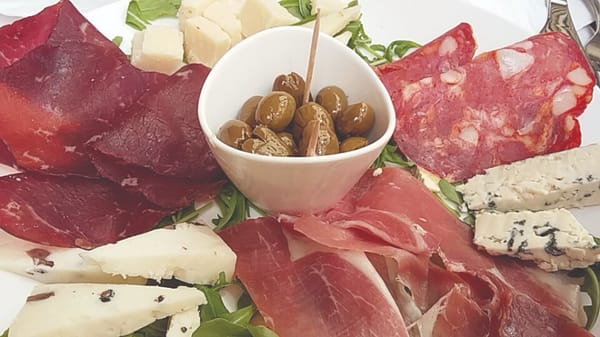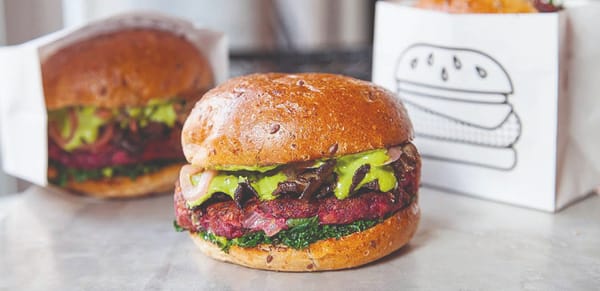Felix Food taste test: instant ramen flavours
As exam season continues to crunch, a group of intrepid Felix writers gave their verdict on varieties of instant ramen on offer across campus. They barely make it out alive.

There is, fairly or unfairly, perhaps no meal more closely associated with the student experience than instant ramen. Different universities may have their own iconic foodstuffs, but the ubiquity of instant noodles seems to cut across time and space. At the most basic level, instant noodles appeal to students because they have the twin virtues of being quick and cheap, making them handy in an environment where neither time nor money are particularly forthcoming. They also conform to a long-held prejudice against students: that we are too lazy, or too stupid, or both, to cook for ourselves.
While the exam period is beginning to wind down for some people, others have yet to even start, and, as the student loan begins to fritter away, Deliveroo is becoming a less-viable option for late-night library sessions. As always, instant noodles will have your back. In the interest of bringing you all the most relevant content, an intrepid gang from the Felix editorial team took it upon themselves to taste-test some of the many varieties of ramen available on campus. It was, in the words of one participant, “a stomach ache waiting to happen”. Not all heroes wear capes.
We head first to the Union Shop, but the pots on offer are too small, and we feel we would be left hungry. Little did we know. Instead, we head down to Essentials, cutting across the shade of Prince’s Lawn, and pick out five varieties of ramen, bringing them back to the office for testing. Within each round, squat container there is a tangled nest of dried noodles, along with various packets, whose contents – beige, ash-like powders; dehydrated peas that resemble little pills; blobs of off-white fat, solidified into glistening clumps – are a mystery, united only by a presumed reliance on MSG. A message, printed on the side of some of the packets, cheerfully exhorts us to ‘share great taste with your friends’, as if a package of instant noodles for one is anything other than the loneliest meal in the world.
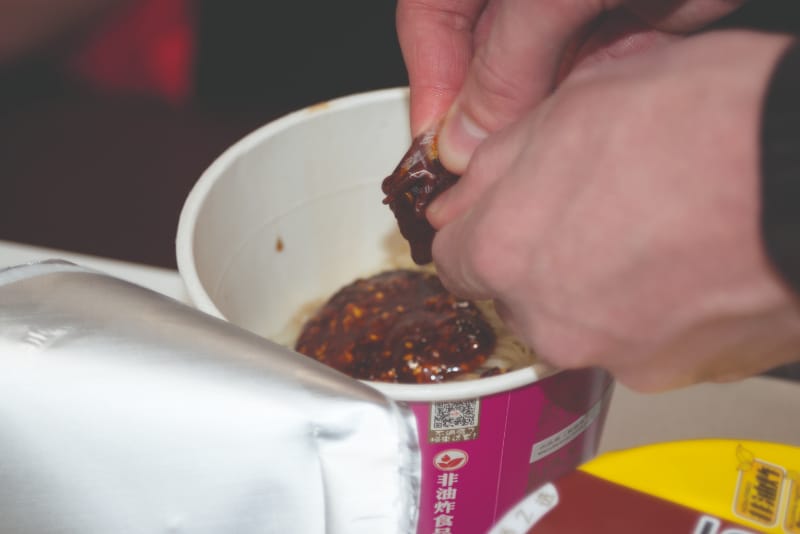
PHO GA
This is the first type we try, which is lucky, since its flavour is quite muted, and few of the later varieties will leave our taste buds fully intact. Some would call the flavour of the Pho Ga delicate; others would say it is non-existent; one participant simply says “no” when he tries it. The dish, supposedly modelled after the popular Thai food, has nothing to it other than texture; the flavour is entirely bland. Pieces of what we assume are meant to be dehydrated chicken bob around the pot, like overgrown sea-monkeys; I put a piece in my mouth, and it squeaks against my molars, like a piece of fatty gristle.
“The pack says ‘share with your friends!’, as if instant ramen weren’t the loneliest meal in the world”
All of the ramen come with little plastic forks, but the one included with the Pho Ga is different – with a thinner stem, wider head, and three prongs, it resembles more of a trident than a fork, allowing its wielder to live out their Poseidon fantasy. It’s an apt choice: the flat noodles are akin to some kind of deep sea creature, perhaps a hive of eels, or those long worms that peek out near volcanic vents. They wriggle and flap, barely able to stay on the fork long enough to take a bite. When we’re finally able to get them to our lips, they are completely tasteless, wet and slimy, and – despite the hot broth – somewhat clammy. It’s not an auspicious start to our experiment.
Score: 3/10
ARTIFICIAL STEWED PORK CUTLET FLAVOUR
On the surface, this doesn’t appear promising; the name alone is enough to turn us off. If there is any word that could make the idea of ‘stewed pork cutlet’ less appetising, ‘artificial’ is pretty high up there. But after the boiling water is poured in, this ramen cup is what most closely resembles the instant noodles of childhood: curly thin noodles, looping and swirling around each other like tangled yarn, floating in an orangey-green liquid, and flecked with shards of green, which could be dried herbs, but could also just be pieces of plastic.
One participant has already tapped out by this point; eschewing tasting, he instead sniffs each cup, giving his olfactory rating. To him, this one smells like “the floor of a Chinese restaurant”, but the taste is surprisingly inoffensive. There’s a strong hit of generic stock, with undertones of extreme saltiness. It’s quite bland, true, but that is probably to be expected; as a flavourful meal, the dish is lackluster, but it serves as a potent reminder, for me, of the times when I used to be allowed instant noodles as ‘a treat’ at home, so I’m sold, if only on the nostalgia front.
After a discussion, the initial rating we give this pot is a four. However, had we known what culinary horrors lay ahead, I feel we would have been a bit kinder to our poor, boring artificial stewed pork cutlet, so I’m bumping it up to a six.
Score: 6/10
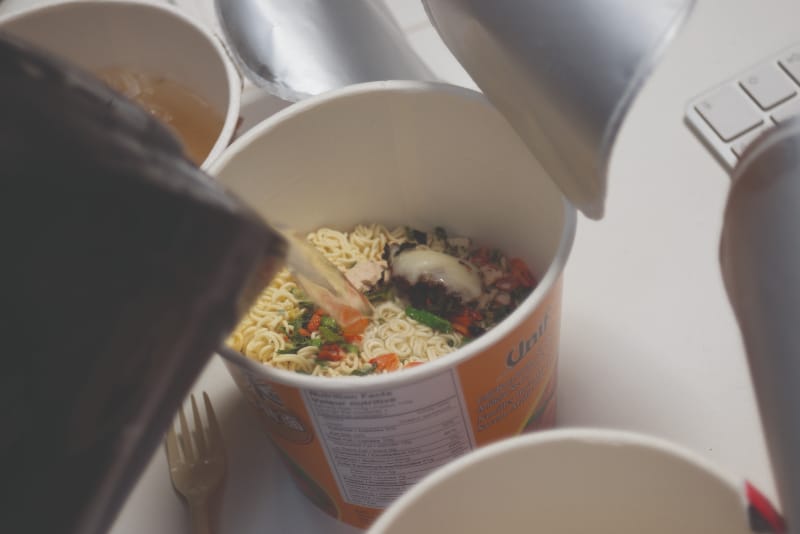
SPICY HOT
During exam season, the Felix Office has become a regular study space, and this variety of ramen is a permanent fixture, so we were quite excited to dive in. Assembling the ramen throws up the first practical challenge: it comes with a packet of chilli oil that has clumped together, chilli flakes glued to each other in small, flat compresses. Getting them out and into the pot is a struggle, and only about two-thirds make it out of the packet.
“One participant says the ramen smells ‘like the floor of a Chinese restaurant’”
In retrospect, this was still far too much. Once the water has been added, the noodles become completely invisible, hidden by a thick layer of chilli oil, a shade of luminous caramine, pooling like blood on the surface. It’s the kind of substance that stains your clothing, and quite possible skin and teeth. In the words of one participant, the dish looks like “my chance of getting a first at this university.”
Still, we push on, dredging up the noodles, which are slick with a layer of glistening oil. The first mouthful burns. It’s not the pleasant burn you get from a finger chili, not even the over-sweetened kind you have with sriracha sauce, but something more corrosive, like a chemical burn. It tastes like the big black and orange crosses on chemical labels. It tastes like the reasons labs have fume cupboards. It tastes like singed hair and heavy industry and silent springs. I don’t know if we can go on.
Score: 0/10
BROAD NOODLE ARTIFICIAL BEEF FLAVOUR HOT POT
In all honestly, I barely remember how this one tasted. In my notes, I’ve written that one participant described the smell as “hot sweat”, but after the Spicy Hot variety I might as well have blacked out, so little do I remember about the experience. All I can recall is being distracted by the texture of the dish: broad, flat noodles wriggle in the broth like giant kelp fronds. Despite leaving the noodles ‘cooking’ far beyond the recommended time, the noodles still feel underdone: they manage to be gelatinous on the outside, but still tough in the middle. They are, on the whole, seemingly-indestructible: our teeth compress them, rather than biting through them, before they spring back to their original shape again. They’re difficult to swallow, slapping against the side of the throat, creating a choking sensation, like being waterboarded from the inside out.
“The first mouthful feels corrosive –something like a chemical burn. It tastes like heavy industry”
With all this sensory overload, the taste leaves no impression on the tongue; the ramen is bland to the point of forgettableness. Either that, or we’ve already burnt our taste buds in the previous challenge. Disappointment is the word that comes to mind. As one participant says, “you know how most food that ends up covering your lips with grease tastes delicious? I feel I’ve been cheated.”
Score: 1/10
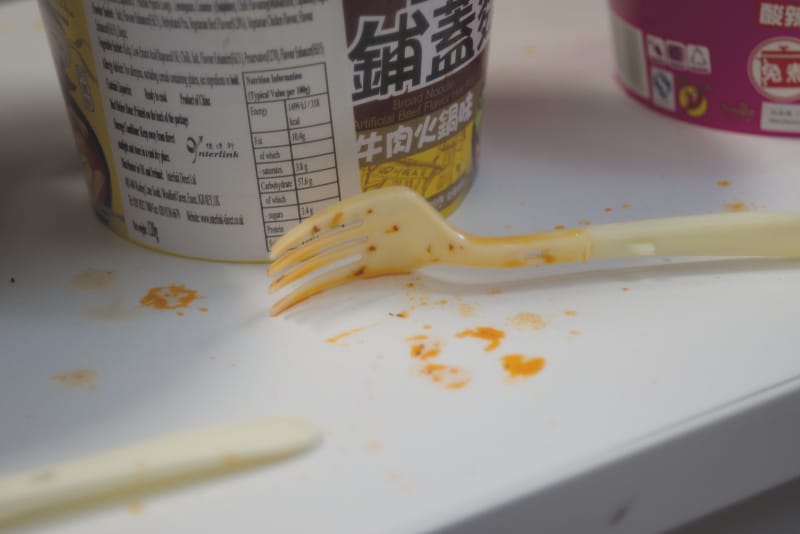
HOT AND SOUR
On occasion, in newspapers or magazines, you come across articles detailing what it is like to suffer from anosmia, or the loss of the sense of smell and taste. Although it might be temporary – most of us have experienced it to some degree during a blocked nose or head cold – in some cases the damage will be permanent. Sufferers describe a world closed off to them: food is like ash in the mouth, a tasteless texture; they are robbed of some of the greatest joys in life, whether that be the ability to taste a fine wine, or the smell of freshly-cut grass in the summer.
Eating the hot and sour ramen, I begin to feel jealous of them. The dish is a complete assault on the senses, so much so I would petition for its existence to be reclassified as a crime against humanity. Problems begin as soon as the packet is opened: a thin brown liquid is poured over the noodles, and a stench of unwashed feet pervades the room, catching in the back of the throat. Decanting some of the thin, slippery noodles into a cup, I can feel the gorge rising in my throat, and I need to pause for a while before I can bring them to my lips.
“Eating the hot and sour ramen, I begin to feel jealous of those who’ve lost their sense of smell and taste”
The noodles have the same undertaste as the hot and spicy variety – a sinister chemical punch – but the overwhelming top note is one of vinegar, which absolutely pummels all other tastes into submission. In comparison with this two-dimensional barrage on our taste buds, the other ramen seem complex and nuanced, like a Canaletto painting, filled with previously-unseen details. My great-grandmother used to drink pickling juice, and I feel even she would balk at this ramen. It tastes like a pail of dirty socks soaked in lye; like the sharp sting of a chemical factory wafting over a motorway on a midsummer’s day; like rotting fruit, macerating into a sour liquor. How anyone could enjoy it is completely beyond us.
Score: 0/10
§
After testing the final variety, none of us are able to stomach any more. We sit back at our desks, returning to work as the saltiness of the noodles makes itself known, dehydrating us into a postprandial stupor, headaches thumping against our temples. The pots sit on the side, rapidly cooling; the thin layers of fat float on the top, before beginning to congeal. We eventually take them out to the bins, the wet noodles making a sickening thwack against the shiny black bags. Back in the office, the smell of the ramen pots – a strong note of star anise, undercut by something putrefying and chemical – hangs in the air, before it dissipates.



